|
|
Abstract
Subversion + Apache + TortiseSVN三個免費軟體可以構成一個強大的備份 + 版本控制平台,本文簡單記錄安裝心得。
Introduction
使用環境:Windows XP SP2 + Subversion 1.6.3 + Apache 2.2.11 + TortoiseSVN 1.6.3
TortoiseSVN-1.6.3.16613-win32-svn-1.6.3.msi
apache_2.2.11-win32-x86-no_ssl.msi
Setup-Subversion-1.6.3.msi
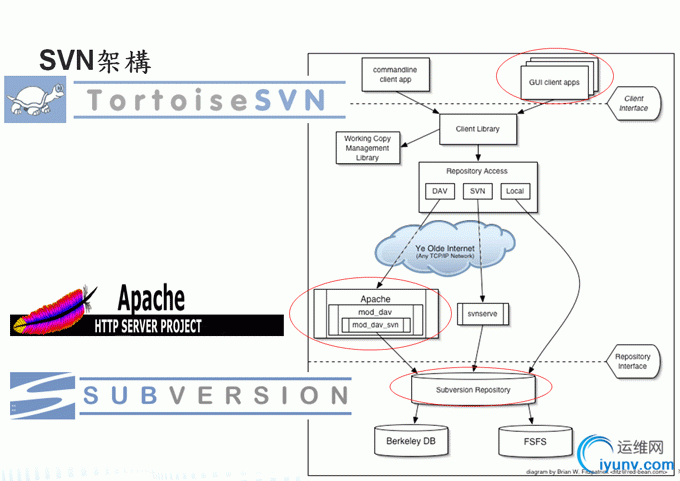
安裝順序:TortiseSVN –> Apache –> Subversion
安裝TortoiseSVN
依照指示下一步下一步安裝即可,唯因為TortoiseSVN以整合至檔案總管,所以一定要重新開機。 安裝Apache
Step 1:
選擇 for All user, on Port 80, as a service -- Recommended
若IIS已經占據80 port,或者IT擋了80 port,安裝完成後到c:\Programe Files\Apache Software Foundation\Apache2.2\conf\httpd.conf 去改port,將
Listen 80
改成你要的port
Step 2:
測試Apache是否安裝成功
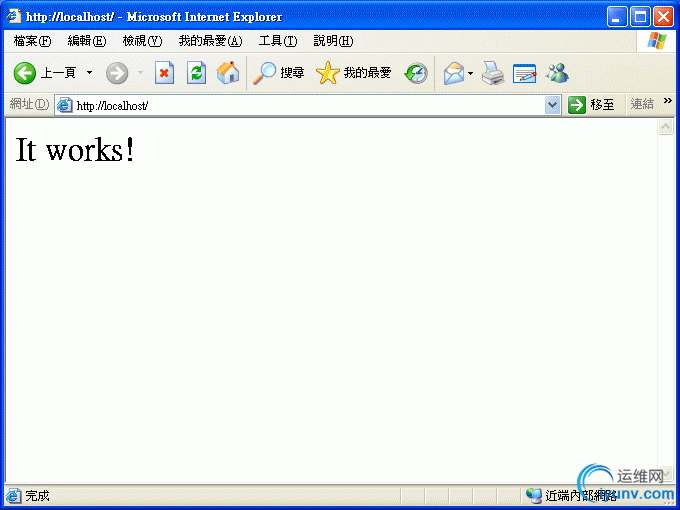
安裝Subversion
Step 1:
下載Subversion
到http://subversion.tigris.org/servlets/ProjectDocumentList?folderID=8100下載Subversion,Subversion的版本必須與Apache的版本相搭配才可安裝成功。
Step 2:
修改httpd.conf
修改C:\Program Files\Apache Software Foundation\Apache2.2\conf\httpd.conf
拿掉#
#LoadModule dav_fs_module modules/mod_dav_fs.so
#LoadModule dav_module modules/mod_dav.so
成
LoadModule dav_fs_module modules/mod_dav_fs.so
LoadModule dav_module modules/mod_dav.so
加入
LoadModule dav_svn_module "C:\Program Files\Subversion\bin\mod_dav_svn.so"
LoadModule authz_svn_module "C:\Program Files\Subversion\bin\mod_authz_svn.so"
在httpd.conf最後加上
DAV svn
SVNParentPath "D:/SVN"
# how to authenticate a user
AuthType Basic
AuthName "Subversion repository"
AuthUserFile "D:/SVN/passwd.ini"
# only authenticated users may access the repository
Require valid-user
意義為
設定SVN虛擬目錄為/svn
SVN的根目錄為d:\SVN
使用基本驗證,檔案為passwd.ini
完整httpd.conf如下所示
1 #
2 # This is the main Apache HTTP server configuration file. It contains the
3 # configuration directives that give the server its instructions.
4 # See for detailed information.
5 # In particular, see
6 #
7 # for a discussion of each configuration directive.
8 #
9 # Do NOT simply read the instructions in here without understanding
10 # what they do. They're here only as hints or reminders. If you are unsure
11 # consult the online docs. You have been warned.
12 #
13 # Configuration and logfile names: If the filenames you specify for many
14 # of the server's control files begin with "/" (or "drive:/" for Win32), the
15 # server will use that explicit path. If the filenames do *not* begin
16 # with "/", the value of ServerRoot is prepended -- so "logs/foo.log"
17 # with ServerRoot set to "C:/Program Files/Apache Software Foundation/Apache2.2" will be interpreted by the
18 # server as "C:/Program Files/Apache Software Foundation/Apache2.2/logs/foo.log".
19 #
20 # NOTE: Where filenames are specified, you must use forward slashes
21 # instead of backslashes (e.g., "c:/apache" instead of "c:\apache").
22 # If a drive letter is omitted, the drive on which httpd.exe is located
23 # will be used by default. It is recommended that you always supply
24 # an explicit drive letter in absolute paths to avoid confusion.
25
26 #
27 # ServerRoot: The top of the directory tree under which the server's
28 # configuration, error, and log files are kept.
29 #
30 # Do not add a slash at the end of the directory path. If you point
31 # ServerRoot at a non-local disk, be sure to point the LockFile directive
32 # at a local disk. If you wish to share the same ServerRoot for multiple
33 # httpd daemons, you will need to change at least LockFile and PidFile.
34 #
35 ServerRoot "C:/Program Files/Apache Software Foundation/Apache2.2"
36
37 #
38 # Listen: Allows you to bind Apache to specific IP addresses and/or
39 # ports, instead of the default. See also the
40 # directive.
41 #
42 # Change this to Listen on specific IP addresses as shown below to
43 # prevent Apache from glomming onto all bound IP addresses.
44 #
45 #Listen 12.34.56.78:80
46 Listen 80
47
48 #
49 # Dynamic Shared Object (DSO) Support
50 #
51 # To be able to use the functionality of a module which was built as a DSO you
52 # have to place corresponding `LoadModule' lines at this location so the
53 # directives contained in it are actually available _before_ they are used.
54 # Statically compiled modules (those listed by `httpd -l') do not need
55 # to be loaded here.
56 #
57 # Example:
58 # LoadModule foo_module modules/mod_foo.so
59 #
60 LoadModule actions_module modules/mod_actions.so
61 LoadModule alias_module modules/mod_alias.so
62 LoadModule asis_module modules/mod_asis.so
63 LoadModule auth_basic_module modules/mod_auth_basic.so
64 #LoadModule auth_digest_module modules/mod_auth_digest.so
65 #LoadModule authn_alias_module modules/mod_authn_alias.so
66 #LoadModule authn_anon_module modules/mod_authn_anon.so
67 #LoadModule authn_dbd_module modules/mod_authn_dbd.so
68 #LoadModule authn_dbm_module modules/mod_authn_dbm.so
69 LoadModule authn_default_module modules/mod_authn_default.so
70 LoadModule authn_file_module modules/mod_authn_file.so
71 #LoadModule authnz_ldap_module modules/mod_authnz_ldap.so
72 #LoadModule authz_dbm_module modules/mod_authz_dbm.so
73 LoadModule authz_default_module modules/mod_authz_default.so
74 LoadModule authz_groupfile_module modules/mod_authz_groupfile.so
75 LoadModule authz_host_module modules/mod_authz_host.so
76 #LoadModule authz_owner_module modules/mod_authz_owner.so
77 LoadModule authz_user_module modules/mod_authz_user.so
78 LoadModule autoindex_module modules/mod_autoindex.so
79 #LoadModule cache_module modules/mod_cache.so
80 #LoadModule cern_meta_module modules/mod_cern_meta.so
81 LoadModule cgi_module modules/mod_cgi.so
82 #LoadModule charset_lite_module modules/mod_charset_lite.so
83 LoadModule dav_module modules/mod_dav.so
84 LoadModule dav_fs_module modules/mod_dav_fs.so
85 #LoadModule dav_lock_module modules/mod_dav_lock.so
86 #LoadModule dbd_module modules/mod_dbd.so
87 #LoadModule deflate_module modules/mod_deflate.so
88 LoadModule dir_module modules/mod_dir.so
89 #LoadModule disk_cache_module modules/mod_disk_cache.so
90 #LoadModule dumpio_module modules/mod_dumpio.so
91 LoadModule env_module modules/mod_env.so
92 #LoadModule expires_module modules/mod_expires.so
93 #LoadModule ext_filter_module modules/mod_ext_filter.so
94 #LoadModule file_cache_module modules/mod_file_cache.so
95 #LoadModule filter_module modules/mod_filter.so
96 #LoadModule headers_module modules/mod_headers.so
97 #LoadModule ident_module modules/mod_ident.so
98 #LoadModule imagemap_module modules/mod_imagemap.so
99 LoadModule include_module modules/mod_include.so
100 #LoadModule info_module modules/mod_info.so
101 LoadModule isapi_module modules/mod_isapi.so
102 #LoadModule ldap_module modules/mod_ldap.so
103 #LoadModule logio_module modules/mod_logio.so
104 LoadModule log_config_module modules/mod_log_config.so
105 #LoadModule log_forensic_module modules/mod_log_forensic.so
106 #LoadModule mem_cache_module modules/mod_mem_cache.so
107 LoadModule mime_module modules/mod_mime.so
108 #LoadModule mime_magic_module modules/mod_mime_magic.so
109 LoadModule negotiation_module modules/mod_negotiation.so
110 #LoadModule proxy_module modules/mod_proxy.so
111 #LoadModule proxy_ajp_module modules/mod_proxy_ajp.so
112 #LoadModule proxy_balancer_module modules/mod_proxy_balancer.so
113 #LoadModule proxy_connect_module modules/mod_proxy_connect.so
114 #LoadModule proxy_ftp_module modules/mod_proxy_ftp.so
115 #LoadModule proxy_http_module modules/mod_proxy_http.so
116 #LoadModule rewrite_module modules/mod_rewrite.so
117 LoadModule setenvif_module modules/mod_setenvif.so
118 #LoadModule speling_module modules/mod_speling.so
119 #LoadModule ssl_module modules/mod_ssl.so
120 #LoadModule status_module modules/mod_status.so
121 #LoadModule substitute_module modules/mod_substitute.so
122 #LoadModule unique_id_module modules/mod_unique_id.so
123 #LoadModule userdir_module modules/mod_userdir.so
124 #LoadModule usertrack_module modules/mod_usertrack.so
125 #LoadModule version_module modules/mod_version.so
126 #LoadModule vhost_alias_module modules/mod_vhost_alias.so
127 LoadModule dav_svn_module "C:\Program Files\Subversion\bin\mod_dav_svn.so"
128 LoadModule authz_svn_module "C:\Program Files\Subversion\bin\mod_authz_svn.so"
129
130
131
132 #
133 # If you wish httpd to run as a different user or group, you must run
134 # httpd as root initially and it will switch.
135 #
136 # User/Group: The name (or #number) of the user/group to run httpd as.
137 # It is usually good practice to create a dedicated user and group for
138 # running httpd, as with most system services.
139 #
140 User daemon
141 Group daemon
142
143
144
145
146 # 'Main' server configuration
147 #
148 # The directives in this section set up the values used by the 'main'
149 # server, which responds to any requests that aren't handled by a
150 # definition. These values also provide defaults for
151 # any containers you may define later in the file.
152 #
153 # All of these directives may appear inside containers,
154 # in which case these default settings will be overridden for the
155 # virtual host being defined.
156 #
157
158 #
159 # ServerAdmin: Your address, where problems with the server should be
160 # e-mailed. This address appears on some server-generated pages, such
161 # as error documents. e.g. admin@your-domain.com
162 #
163 ServerAdmin admin@oomusouvm.localdomain
164
165 #
166 # ServerName gives the name and port that the server uses to identify itself.
167 # This can often be determined automatically, but we recommend you specify
168 # it explicitly to prevent problems during startup.
169 #
170 # If your host doesn't have a registered DNS name, enter its IP address here.
171 #
172 #ServerName oomusouvm.localdomain:80
173
174 #
175 # DocumentRoot: The directory out of which you will serve your
176 # documents. By default, all requests are taken from this directory, but
177 # symbolic links and aliases may be used to point to other locations.
178 #
179 DocumentRoot "C:/Program Files/Apache Software Foundation/Apache2.2/htdocs"
180
181 #
182 # Each directory to which Apache has access can be configured with respect
183 # to which services and features are allowed and/or disabled in that
184 # directory (and its subdirectories).
185 #
186 # First, we configure the "default" to be a very restrictive set of
187 # features.
188 #
189
190 Options FollowSymLinks
191 AllowOverride None
192 Order deny,allow
193 Deny from all
194
195
196 #
197 # Note that from this point forward you must specifically allow
198 # particular features to be enabled - so if something's not working as
199 # you might expect, make sure that you have specifically enabled it
200 # below.
201 #
202
203 #
204 # This should be changed to whatever you set DocumentRoot to.
205 #
206
207 #
208 # Possible values for the Options directive are "None", "All",
209 # or any combination of:
210 # Indexes Includes FollowSymLinks SymLinksifOwnerMatch ExecCGI MultiViews
211 #
212 # Note that "MultiViews" must be named *explicitly* --- "Options All"
213 # doesn't give it to you.
214 #
215 # The Options directive is both complicated and important. Please see
216 # http://httpd.apache.org/docs/2.2/mod/core.html#options
217 # for more information.
218 #
219 Options Indexes FollowSymLinks
220
221 #
222 # AllowOverride controls what directives may be placed in .htaccess files.
223 # It can be "All", "None", or any combination of the keywords:
224 # Options FileInfo AuthConfig Limit
225 #
226 AllowOverride None
227
228 #
229 # Controls who can get stuff from this server.
230 #
231 Order allow,deny
232 Allow from all
233
234
235
236 #
237 # DirectoryIndex: sets the file that Apache will serve if a directory
238 # is requested.
239 #
240
241 DirectoryIndex index.html
242
243
244 #
245 # The following lines prevent .htaccess and .htpasswd files from being
246 # viewed by Web clients.
247 #
248
249 Order allow,deny
250 Deny from all
251 Satisfy All
252
253
254 #
255 # ErrorLog: The location of the error log file.
256 # If you do not specify an ErrorLog directive within a
257 # container, error messages relating to that virtual host will be
258 # logged here. If you *do* define an error logfile for a
259 # container, that host's errors will be logged there and not here.
260 #
261 ErrorLog "logs/error.log"
262
263 #
264 # LogLevel: Control the number of messages logged to the error_log.
265 # Possible values include: debug, info, notice, warn, error, crit,
266 # alert, emerg.
267 #
268 LogLevel warn
269
270
271 #
272 # The following directives define some format nicknames for use with
273 # a CustomLog directive (see below).
274 #
275 LogFormat "%h %l %u %t \"%r\" %>s %b \"%{Referer}i\" \"%{User-Agent}i\"" combined
276 LogFormat "%h %l %u %t \"%r\" %>s %b" common
277
278
279 # You need to enable mod_logio.c to use %I and %O
280 LogFormat "%h %l %u %t \"%r\" %>s %b \"%{Referer}i\" \"%{User-Agent}i\" %I %O" combinedio
281
282
283 #
284 # The location and format of the access logfile (Common Logfile Format).
285 # If you do not define any access logfiles within a
286 # container, they will be logged here. Contrariwise, if you *do*
287 # define per- access logfiles, transactions will be
288 # logged therein and *not* in this file.
289 #
290 CustomLog "logs/access.log" common
291
292 #
293 # If you prefer a logfile with access, agent, and referer information
294 # (Combined Logfile Format) you can use the following directive.
295 #
296 #CustomLog "logs/access.log" combined
297
298
299
300 #
301 # Redirect: Allows you to tell clients about documents that used to
302 # exist in your server's namespace, but do not anymore. The client
303 # will make a new request for the document at its new location.
304 # Example:
305 # Redirect permanent /foo http://oomusouvm.localdomain/bar
306
307 #
308 # Alias: Maps web paths into filesystem paths and is used to
309 # access content that does not live under the DocumentRoot.
310 # Example:
311 # Alias /webpath /full/filesystem/path
312 #
313 # If you include a trailing / on /webpath then the server will
314 # require it to be present in the URL. You will also likely
315 # need to provide a section to allow access to
316 # the filesystem path.
317
318 #
319 # ScriptAlias: This controls which directories contain server scripts.
320 # ScriptAliases are essentially the same as Aliases, except that
321 # documents in the target directory are treated as applications and
322 # run by the server when requested rather than as documents sent to the
323 # client. The same rules about trailing "/" apply to ScriptAlias
324 # directives as to Alias.
325 #
326 ScriptAlias /cgi-bin/ "C:/Program Files/Apache Software Foundation/Apache2.2/cgi-bin/"
327
328
329
330
331 #
332 # ScriptSock: On threaded servers, designate the path to the UNIX
333 # socket used to communicate with the CGI daemon of mod_cgid.
334 #
335 #Scriptsock logs/cgisock
336
337
338 #
339 # "C:/Program Files/Apache Software Foundation/Apache2.2/cgi-bin" should be changed to whatever your ScriptAliased
340 # CGI directory exists, if you have that configured.
341 #
342
343 AllowOverride None
344 Options None
345 Order allow,deny
346 Allow from all
347
348
349 #
350 # DefaultType: the default MIME type the server will use for a document
351 # if it cannot otherwise determine one, such as from filename extensions.
352 # If your server contains mostly text or HTML documents, "text/plain" is
353 # a good value. If most of your content is binary, such as applications
354 # or images, you may want to use "application/octet-stream" instead to
355 # keep browsers from trying to display binary files as though they are
356 # text.
357 #
358 DefaultType text/plain
359
360
361 #
362 # TypesConfig points to the file containing the list of mappings from
363 # filename extension to MIME-type.
364 #
365 TypesConfig conf/mime.types
366
367 #
368 # AddType allows you to add to or override the MIME configuration
369 # file specified in TypesConfig for specific file types.
370 #
371 #AddType application/x-gzip .tgz
372 #
373 # AddEncoding allows you to have certain browsers uncompress
374 # information on the fly. Note: Not all browsers support this.
375 #
376 #AddEncoding x-compress .Z
377 #AddEncoding x-gzip .gz .tgz
378 #
379 # If the AddEncoding directives above are commented-out, then you
380 # probably should define those extensions to indicate media types:
381 #
382 AddType application/x-compress .Z
383 AddType application/x-gzip .gz .tgz
384
385 #
386 # AddHandler allows you to map certain file extensions to "handlers":
387 # actions unrelated to filetype. These can be either built into the server
388 # or added with the Action directive (see below)
389 #
390 # To use CGI scripts outside of ScriptAliased directories:
391 # (You will also need to add "ExecCGI" to the "Options" directive.)
392 #
393 #AddHandler cgi-script .cgi
394
395 # For type maps (negotiated resources):
396 #AddHandler type-map var
397
398 #
399 # Filters allow you to process content before it is sent to the client.
400 #
401 # To parse .shtml files for server-side includes (SSI):
402 # (You will also need to add "Includes" to the "Options" directive.)
403 #
404 #AddType text/html .shtml
405 #AddOutputFilter INCLUDES .shtml
406
407
408 #
409 # The mod_mime_magic module allows the server to use various hints from the
410 # contents of the file itself to determine its type. The MIMEMagicFile
411 # directive tells the module where the hint definitions are located.
412 #
413 #MIMEMagicFile conf/magic
414
415 #
416 # Customizable error responses come in three flavors:
417 # 1) plain text 2) local redirects 3) external redirects
418 #
419 # Some examples:
420 #ErrorDocument 500 "The server made a boo boo."
421 #ErrorDocument 404 /missing.html
422 #ErrorDocument 404 "/cgi-bin/missing_handler.pl"
423 #ErrorDocument 402 http://oomusouvm.localdomain/subscription_info.html
424 #
425
426 #
427 # EnableMMAP and EnableSendfile: On systems that support it,
428 # memory-mapping or the sendfile syscall is used to deliver
429 # files. This usually improves server performance, but must
430 # be turned off when serving from networked-mounted
431 # filesystems or if support for these functions is otherwise
432 # broken on your system.
433 #
434 #EnableMMAP off
435 #EnableSendfile off
436
437 # Supplemental configuration
438 #
439 # The configuration files in the conf/extra/ directory can be
440 # included to add extra features or to modify the default configuration of
441 # the server, or you may simply copy their contents here and change as
442 # necessary.
443
444 # Server-pool management (MPM specific)
445 #Include conf/extra/httpd-mpm.conf
446
447 # Multi-language error messages
448 #Include conf/extra/httpd-multilang-errordoc.conf
449
450 # Fancy directory listings
451 #Include conf/extra/httpd-autoindex.conf
452
453 # Language settings
454 #Include conf/extra/httpd-languages.conf
455
456 # User home directories
457 #Include conf/extra/httpd-userdir.conf
458
459 # Real-time info on requests and configuration
460 #Include conf/extra/httpd-info.conf
461
462 # Virtual hosts
463 #Include conf/extra/httpd-vhosts.conf
464
465 # Local access to the Apache HTTP Server Manual
466 #Include conf/extra/httpd-manual.conf
467
468 # Distributed authoring and versioning (WebDAV)
469 #Include conf/extra/httpd-dav.conf
470
471 # Various default settings
472 #Include conf/extra/httpd-default.conf
473
474 # Secure (SSL/TLS) connections
475 #Include conf/extra/httpd-ssl.conf
476 #
477 # Note: The following must must be present to support
478 # starting without SSL on platforms with no /dev/random equivalent
479 # but a statically compiled-in mod_ssl.
480 #
481
482 SSLRandomSeed startup builtin
483 SSLRandomSeed connect builtin
484
485
486
487 DAV svn
488 SVNParentPath "D:/SVN"
489
490 # how to authenticate a user
491 AuthType Basic
492 AuthName "Subversion repository"
493 AuthUserFile "D:/SVN/passwd.ini"
494
495 # only authenticated users may access the repository
496 Require valid-user
497
Step 3:
建立passwd.ini
目錄切換到d:\SVN
D:\SVN>"c:\Program Files\Apache Software Foundation\Apache2.2\bin\htpasswd.exe" -c passwd.ini oomusou
新增其他帳號
D:\SVN>"c:\Program Files\Apache Software Foundation\Apache2.2\bin\htpasswd.exe" passwd.ini clare
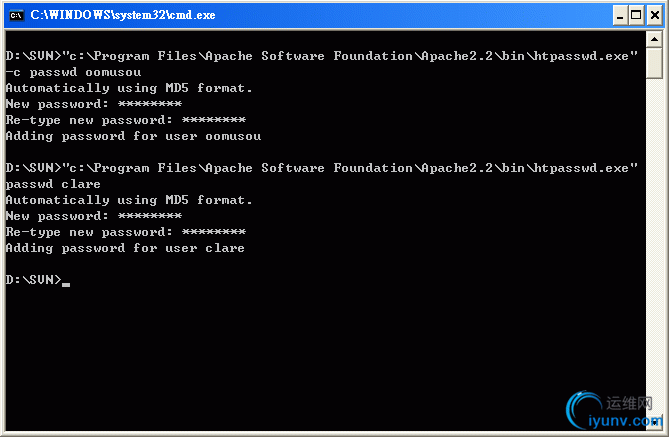
Step 4:
建立Repository
svnadmin create project1
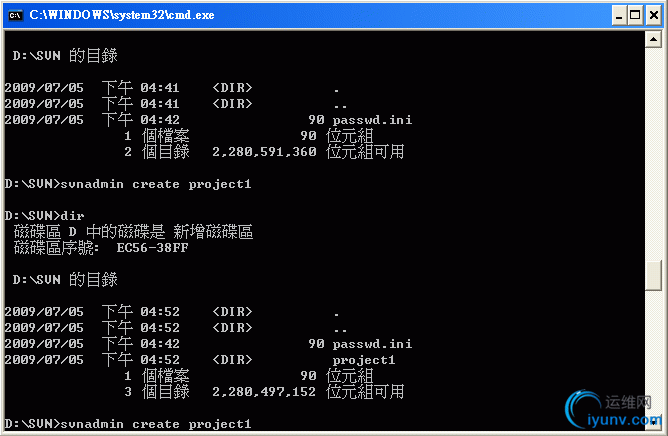
Step 5:
重新啟動Apache
Step 6:
測試SVN是否安裝成功
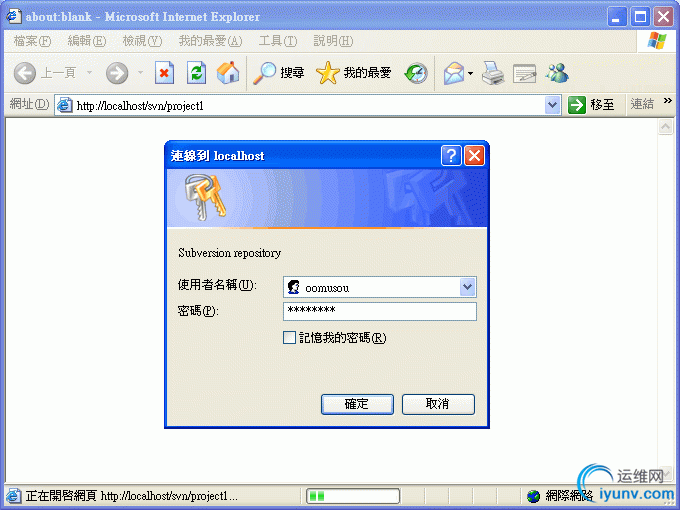

Conclusion
TortoiseSVN Help有詳細的參考資訊,不過若跟著安裝卻裝不起來,我是綜合TortoiseSVN Help與在 Win32 安裝 Apache 2.2 with OpenSSL + Subversion 1.5的方法才安裝成功。 Reference
TortoiseSVN Help的TortoiseSVN\The Repository\Apache Based Server\Installing Apache與TortoiseSVN\The Repository\Apache Based Server\Installing Subversion
在 Win32 安裝 Apache 2.2 with OpenSSL + Subversion 1.5
如何在 Win32 安裝 Apache 2.0 with OpenSSL + Subversion 1.4 |
|